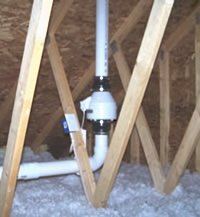|
Build your home Radon Gas ResistantWhat is radon gas & where does it come from? Radon is a naturally occurring gaseous element that forms during the decay of Uranium-238 in the ground. Radon concentrations vary from one location to the next but will be higher in areas that have high uranium soil concentrations. You can view a map of all counties in the United States on EPA’s website, www.epa.gov/radon to determine if your area is high risk of elevated radon & there are several informational publications that can be downloaded. Radon is a toxic carcinogenic gas. What makes it dangerous is that it is completely colorless and odorless. Because radon is a decay product of uranium, occurring naturally in the soil, it can enter your home through cracks in the foundation, exposed rock and well water.
What are the health effects of radon? While there are no immediate symptoms or health effects from exposure to radon, it is in fact a health risk. Several separate studies have linked radon found in homes to lung cancer. The U.S. Surgeon General has also warned the American public about the risks of poor indoor air quality due to radon gas concentrations. Poor indoor air quality due to radon exposure is the estimated cause of 21,000 lung cancer deaths in the United States alone. This makes radon one of the leading causes of lung cancer, second only to smoking. Cases of lung cancer have been found to occur 5-25 years after exposure. There is no evidence linking radon to other respiratory diseases such as asthma or chronic sinusitis. Also, there is nothing to indicate that children are at any greater risk than adults. What are the safe levels of radon gas? The average level of radon found in indoors is 1.3 picocuries per liter (pCi/L). The EPA's recommended action level is anything above 4 pCi/L. An average of 1 out of every 15 homes in the United States has an indoor radon level at or above the recommended action level. In our area of the Western Carolinas, (we are a Zone 1 which has the highest potential for radon), 28% (1 out of every 4) of the homes are at or above 4.0 pCi/l.Radon can be a problem in any type of home regardless of how new it is and even if it does not have a basement. Based upon actual testing in our area, 7% of crawlspace homes are high, 30% of concrete slab homes are high & 45% of basement homes are high. The only way to be certain that your indoor air quality has safe levels of radon is to test it. Radon testing kits can be purchased either online or at many local hardware stores or you can have a professional do the testing, you can certified providers at www.radongas.org How can I reduce the radon levels in my home? If you are building a new home, the land cannot be tested before it is built, only after it is 100% complete. It is very important to design/build your home using radon resistant techniques and install a passive radon pipe so that if the home measures high after its complete, mitigation will be simple and less costly.Radon gas levels can be reduced through various simple methods. Since radon is a gas it can be vented outdoors. Installing an active ventilation system in areas found to have high radon concentrations helps to improve indoor air quality in the long run. Sealing foundation cracks and other paths radon may use to enter homes will help prevent future problems as well. Radon is a harmful substance and can only found if tested for. Home radon testing is easy, inexpensive and reliable. If you find you have poor indoor air quality due to high radon concentrations, a qualified contractor can easily fix the problem.
|
Building Tip
"Have your home tested for radon gas, especially if it is a basement. Most basement homes will need an active radon mitigation system, so plan on it. Consider installing an active system regardless of the reading, therefore you are ensured low levels of radon all the time."

The above picture is an active radon mitigation system with the fan installed in the attic.
INSPIRING THOUGHT
"The one piece of advice I can give you is, do what turns you on. Do something that if you had all the money in the world, you’d still be doing it. You’ve got to have a reason to jump out of bed in the morning."
~ Warren Buffett:
